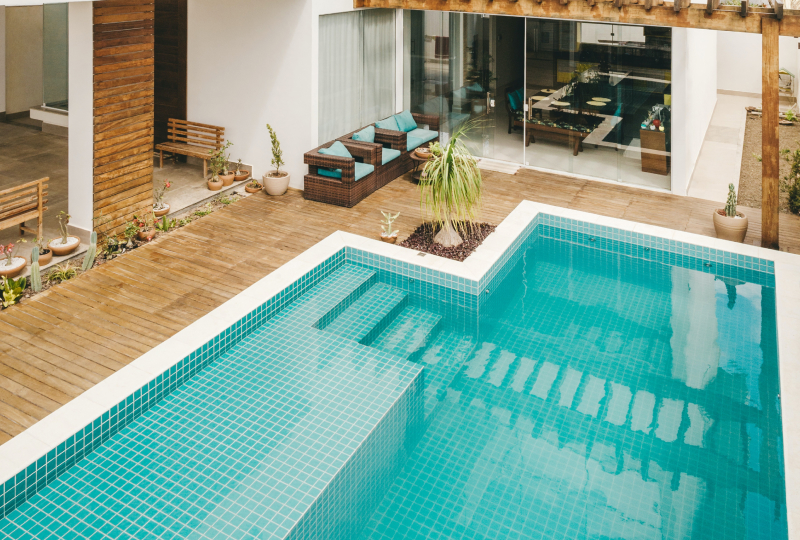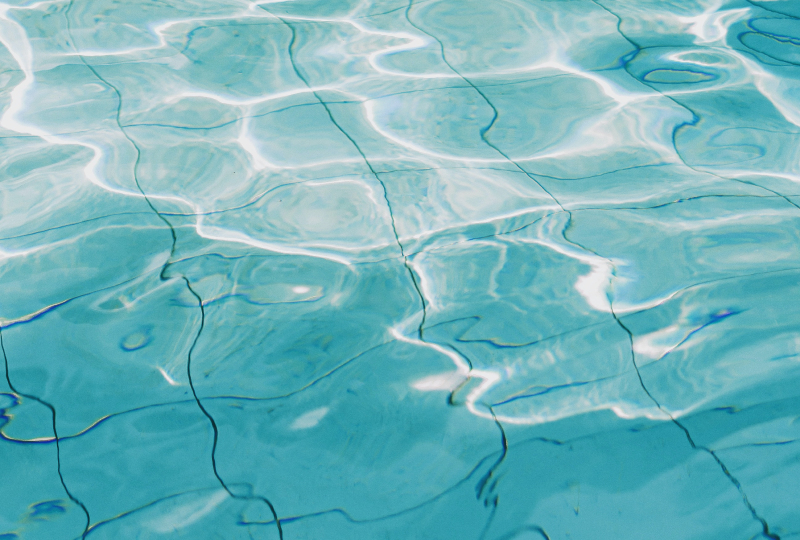
Swimming Pools: Pool Types, Components, and How They Work
Jump To Section:
Types of Swimming Pools
Different Types of Above Ground Pools
Different Types of Inground Pools
Components of a Swimming Pool
Basic Parts of a Swimming Pool
How does a Pool Pump Work?
How does a Pool Skimmer Work?
How does a Pool Main Drain Work?
How Does a Pool Filter Work?
How Do Pool Jets Work?
How Does a Pool Work?
Types Of Swimming Pools
There are two main types of swimming pools: above ground and inground.
Different Types of Above Ground Pools
Above ground pools are suitable for homeowners working with a smaller budget. Typically costing between $1,850-5,000 to install, above ground pools can be installed in a short timeframe using a variety of designs and materials. Even with a deck added around the pool, the overall budget will still be less than other pool types.
A key advantage of an above ground pool is the safety aspect. Since the pool entry is high off the ground, there’s a less likely chance of people or pets falling in. However, this type of pool is less aesthetically appealing and has a shorter lifespan than inground pools.
Different Types of Inground Pools
Inground pools are a common type of swimming pool, with three different material options available: fiberglass, vinyl, and concrete.
An inground pool can add resale value but also typically requires an extensive amount of routine maintenance. Pricing can vary widely, with an average cost being $35,000. Depending on the type of inground swimming pool, there may be some flexibility regarding size and shape. Some types are more durable than others.

Fiberglass Pools
Fiberglass pools are quick to install since the standard fiberglass shell is simply lowered into an excavated hole. It’s the most expensive pool type to install but relatively easy and affordable to maintain. Usually, a fiberglass pool lasts up to 15 years before showing signs of deterioration.
When cracking and fading occur, repairs may cause visible imperfections. Also, since a fiberglass pool is built from a mold, the shape is not customizable and is limited to 16 feet in width.
Vinyl Pools
Vinyl pools have the lowest installation cost and can be customized to any size and shape. They partner with a sand foundation and vinyl liner with a metal or plastic frame and panels.
Because the liner is thin, it can be easily damaged and typically needs replacing every 5-10 years. It can last up to 18 years if treated with UV and fungus inhibitors.
Concrete Pools
Concrete pools take the longest time to install. The process starts with pouring concrete, the conventional building material for inground pool construction. Plaster then seals the concrete, which can be reapplied throughout the pool’s lifetime. Alternatives to plaster include pebble or glass aggregates and tiles.
Concrete is durable when combined with reinforced steel and typically outlasts the other pool types. It’s also fully customizable. However, this type of inground swimming pool has the most expensive lifetime cost and can be challenging to maintain.
Components Of A Swimming Pool
Basic Parts of a Swimming Pool
There are usually seven basic parts of a typical swimming pool: main drain, skimmer, suction line(s), a pool pump, pool filter, return lines, and return jets.
The main drain, pool skimmer, suction lines, and pool pump are found on the suction side of the pool, where water is drawn in and brought into the filtration system.
The pressure side of the pool (where the water exits the filtration system and re-enters the pool) is home to the filter, return lines, and return jets.
How Does a Pool Main Drain Work?
Most residential pools have two main drains on the pool’s bottom, located in the deepest part of the pool. With the help of suction, they collect any dirt or debris that sinks and makes it into the drains. Covers or grates over the drains prevent people or objects from getting trapped.
Like skimmers, main drains pull water in and enhance circulation – but do this from the pool’s depths rather than the top.
Main drains are also useful when draining the pool.
How Does a Pool Skimmer Work?
A skimmer is where the circulation process begins. Located on the top inside of the pool’s walls, skimmers assist with the collection of debris that floats on the top of the pool water. Housed inside the skimmer is a basket that traps this debris and prevents it from causing filter clogs.
The skimmer baskets can also house slow-releasing chlorine tablets.
How Do Suction Lines Work?
Made from PVC, these pipes travel water from the skimmers and drains to the pool pump.
How Does a Pool Pump Work?
The pool pump works with the motor to pull water from the pool and return it to the pool. It enables water circulation in your pool by creating suction to pull water from the main drains and skimmers. An impeller, powered by a motor, helps this process by spinning quickly and generating a vacuum that pulls the water into the filtration system.
The pool size determines the pump size, with larger pools requiring larger pumps. Three pool pumps are available: single-speed, two-speed, and variable-speed.

How Does a Pool Filter Work?
Once the water goes through the pool pump, it’s sent through a filter. The pool filter eliminates small debris and bacteria from the water while keeping the sanitizing chemicals present. Three main pool filters are available: sand, diatomaceous earth (DE), and cartridge.
How Do Return Lines Work?
A pool’s return lines, which stop at the return jets, are made of PVC piping. They contain water that travels from the filter (and any optional devices) back to the pool.
How Do Pool Jets Work?
Pool jets, also known as return jets, provide the pool with freshly filtered water. They do this by shooting the water at a strong pressure back into the pool, which helps encourage it to mix with existing sanitizers.
There usually are two or three pool jets in an inground pool, whereas above ground pools usually have one.
How Does A Pool Work?
Dirt and debris travel through the pool toward the skimmer, opposite the jet nozzles. The basket inside the skimmer retains the larger debris to prevent blockages in the pump or piping from occurring.
The pool water travels through the suction lines until it reaches a second basket just before the pump impeller. This basket is responsible for retaining smaller debris that has passed through the skimmer basket. The pump propeller continues moving the water toward the main filter.
The selector valve setting determines the function of the filter. When the water reaches the main filter, the water travels through the filter media (i.e., sand, cartridge, or DE), where the smaller particles in the pool water are retained. The filter media filter out solid particles such as dust and pollen.
After the water passes through the filter, it is returned to the pool via the return lines and return jets.

